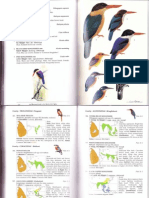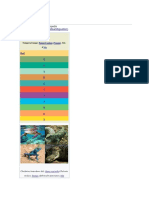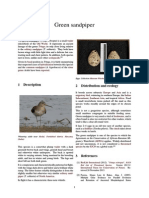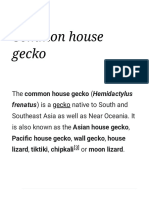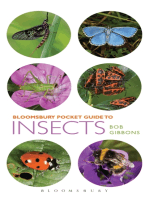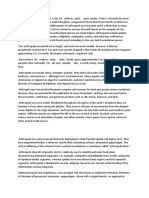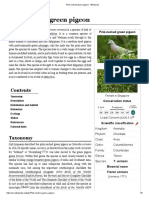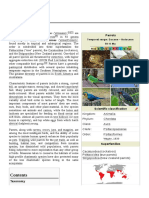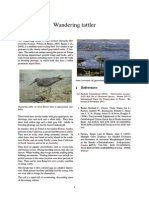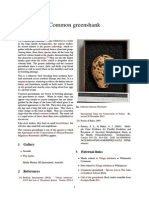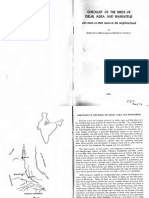Common Redshank: 2 Subspecies
Common Redshank: 2 Subspecies
Uploaded by
jansenCopyright:
Available Formats
Common Redshank: 2 Subspecies
Common Redshank: 2 Subspecies
Uploaded by
jansenOriginal Description:
Original Title
Copyright
Available Formats
Share this document
Did you find this document useful?
Is this content inappropriate?
Copyright:
Available Formats
Common Redshank: 2 Subspecies
Common Redshank: 2 Subspecies
Uploaded by
jansenCopyright:
Available Formats
Common redshank
For the plant called redshank, see Persicaria maculosa. the Arctic, has a longer bill and legs; it is almost entirely
black in breeding plumage and very pale in winter. It is
not a particularly close relative of the common redshank,
The common redshank or simply redshank (Tringa
totanus) is a Eurasian wader in the large family but rather belongs to a high-latitude lineage of largish
shanks. T. totanus on the other hand is closely related
Scolopacidae.
to the marsh sandpiper (T. stagnatilis), and closer still to
the small wood sandpiper (T. glareola). The ancestors
of the latter and the common redshank seem to have diverged around the Miocene-Pliocene boundary, about 56 million years ago. These three subarctic- to temperateregion species form a group of smallish shanks with have
red or yellowish legs, and in breeding plumage are generally a subdued light brown above with some darker mottling, and have somewhat diuse small brownish spots on
the breast and neck.[2]
2 Subspecies
Several subspecies have been identied. These include:
Winter plumage, at Sungei Buloh Wetland Reserve (Singapore)
T. t. robusta: identied by Schiler,[3] 1919 found
in Iceland and the Faroe Islands.
T. t. ussuriensis: identied by Buturlin[4] 1934 found
in southern Siberia, Mongolia and east Asia
Description and systematics
T. t. terrignotae: identied by Meinertzhagen,
R & Meinertzhagen, A, 1926 found in southern
Manchuria and eastern China
T. t. craggi: identied by Hale, 1971 found in north
west China
T. t. eurhina: identied by Oberholser,[5] 1900
found in Tajikistan, north India and Tibet[6][7]
3 Ecology
The common redshank is a widespread breeding bird
across temperate Eurasia. It is a migratory species, wintering on coasts around the Mediterranean, on the Atlantic coast of Europe from Great Britain southwards,
and in South Asia. They are uncommon vagrants outside these areas; on Palau in Micronesia for example, the
species was recorded in the mid-1970s and in 2000.[8]
Bird (non-breeding) in ight (Laguna di Venezia, Italy)
Common redshanks in breeding plumage are a marbled
brown color, slightly lighter below. In winter plumage
they become somewhat lighter-toned and less patterned,
being rather plain greyish-brown above and whitish below. They have red legs and a black-tipped red bill, and They are wary and noisy birds which will alert everything
show white up the back and on the wings in ight.
else with their loud piping call. Like most waders, they
The spotted redshank (T. erythropus), which breeds in feed on small invertebrates. Redshanks will nest in any
1
EXTERNAL LINKS
[6] IOC World Bird List VERSION 3.4 (Accessed August
2013)
[7] Hale, W. G. (1971). A revision of the taxonomy of the
Redshank Tringa totanus. Zoological Journal of the Linnean Society, 50(3), 199-268.
[8] Wiles et al. (2006)
[9] BLI (2008)
5 References
Two redshanks on a stone pillar
Pereira, Srgio Luiz & Baker, Alan J. (2005):
Multiple Gene Evidence for Parallel Evolution
and Retention of Ancestral Morphological States
in the Shanks (Charadriiformes: Scolopacidae).
The Condor 107(3): 514526. DOI:10.1650/00105422(2005)107[0514:MGEFPE]2.0.CO;2 PDF fulltext
Wiles, Gary J.; Johnson, Nathan C.; de Cruz, Justine B.; Dutson, Guy; Camacho, Vicente A.; Kepler, Angela Kay; Vice, Daniel S.; Garrett, Kimball
L.; Kessler, Curt C. & Pratt, H. Douglas (2004):
New and Noteworthy Bird Records for Micronesia,
19862003. Micronesica 37(1): 69-96. HTML abstract
6 External links
Eggs, Collection Museum Wiesbaden
wetland, from damp meadows to saltmarsh, often at high
densities. They lay 3-5 eggs.
The common redshank is one of the species to which the
Agreement on the Conservation of African-Eurasian Migratory Waterbirds (AEWA) applies.
It is widely distributed and quite plentiful in some regions, and thus not considered a threatened species by the
IUCN.[9]
Footnotes
[1] BirdLife International (2013).
"Tringa totanus".
IUCN Red List of Threatened Species (IUCN) 2013:
e.T22693211A50404828. Retrieved 27 October 2015.
[2] Pereira & Baker (2005)
[3] Schiler, E. L., (1919). Om den Islandske Redben (Totunus calidris robustus). Dansk. orn. Foren. XIII: 207211
[4] Buturlin, S. A., (1934). Polnyi Opredelitel Ptitsy SSSR,
I: 88.
[5] Oberholser, H. C., (1900) Birds from Central Asia. Proc.
U.S. natn. Mus., XXII: 207-208.
Chisholm, Hugh, ed.
(1911).
"Redshank".
Encyclopdia Britannica (11th ed.). Cambridge
University Press.
Redshanks Image documentation
Ageing and sexing (PDF; 1.4 MB) by Javier BlascoZumeta & Gerd-Michael Heinze
Text and image sources, contributors, and licenses
7.1
Text
Common redshank Source: https://en.wikipedia.org/wiki/Common_redshank?oldid=688071273 Contributors: Magnus Manske, William
Avery, Jimfbleak, JohnCastle, Robbot, Naddy, Radomil, MPF, Abigail-II, Arne List, Xezbeth, Mwng, Hesperian, Kurt Shaped Box,
HenkvD, Jackhynes, Stemonitis, Issk, Jannex, Miaow Miaow, Bluemoose, Palica, BD2412, Koavf, FlaBot, Eubot, TeaDrinker, Gdrbot, Bgwhite, Kummi, YurikBot, RobotE, Breakinguptheguy, Gaius Cornelius, Dysmorodrepanis~enwiki, Voyevoda, Bota47, Crisco
1492, Lt-wiki-bot, Rhion, Eskimbot, Cato Neimoidia, Colonies Chris, Snowmanradio, Hu12, Bruinfan12, Drinibot, Beastie Bot, Cydebot, Thijs!bot, Escarbot, WikiLambo, JAnDbot, Dnem, MER-C, Sophie means wisdom, WolfmanSF, Andreas Trepte, Pjt56, CommonsDelinker, STBotD, DorganBot, TXiKiBoT, David Condrey, SieBot, Msrasnw, Jmgarg1, The Thing That Should Not Be, Panellet, Kruusamgi, Cantor, Addbot, LaaknorBot, SpBot, First Light, Zorrobot, Luckas-bot, Amirobot, Totodu74, Materialscientist, Xqbot, Boaworm,
Simuliid, Gouerouz, Yanajin33, Louperibot, Leondumontfollower, DexDor, EmausBot, Kmoksy, Maxim Gavrilyuk, PBS-AWB, Sasan700,
ChuispastonBot, Mjbmrbot, BG19bot, Makecat-bot, TGut212, HeinzelMann1, Bartkauz, Foliate08, Coreyemotela, Klausrassinger and
Anonymous: 15
7.2
Images
File:Common_Redshank.jpg Source: https://upload.wikimedia.org/wikipedia/commons/3/3f/Common_Redshank.jpg License: CC
BY-SA 2.0 Contributors: http://www.flickr.com/photos/lipkee/1965452739/ Original artist: Lip Kee
File:Common_Redshank_Tringa_totanus.jpg Source: https://upload.wikimedia.org/wikipedia/commons/4/4e/Common_Redshank_
Tringa_totanus.jpg License: CC BY-SA 2.5 Contributors: <a data-x-rel='nofollow' class='external text' href='http://photo-natur.de/de/
artenliste-systematisch/voegel-sys/63'>Own work</a> Original artist: Andreas Trepte
File:Commons-logo.svg Source: https://upload.wikimedia.org/wikipedia/en/4/4a/Commons-logo.svg License: ? Contributors: ? Original
artist: ?
File:Redshanks_on_stone_pillar.jpg Source: https://upload.wikimedia.org/wikipedia/commons/f/f2/Redshanks_on_stone_pillar.jpg
License: CC BY 3.0 Contributors: Own work Original artist: Boaworm
File:Tringa_totanus-pjt.jpg Source: https://upload.wikimedia.org/wikipedia/commons/a/ae/Tringa_totanus-pjt.jpg License: CC BY 3.0
Contributors: Own work Original artist: pjt56 --- If you use the picture outside Wikipedia I would appreciate a short e-mail to pjt56@gmx.net
File:Tringa_totanus_MWNH_0210.JPG Source: https://upload.wikimedia.org/wikipedia/commons/8/85/Tringa_totanus_MWNH_
0210.JPG License: CC BY-SA 3.0 Contributors: Own work Original artist: Klaus Rassinger und Gerhard Cammerer, Museum Wiesbaden
File:Wikispecies-logo.svg Source: https://upload.wikimedia.org/wikipedia/commons/d/df/Wikispecies-logo.svg License: CC BY-SA
3.0 Contributors: Image:Wikispecies-logo.jpg Original artist: (of code) cs:User:-xfi-
7.3
Content license
Creative Commons Attribution-Share Alike 3.0
You might also like
- Richard Coudenhove-Kalergi - Pan-Europa (2019)Document150 pagesRichard Coudenhove-Kalergi - Pan-Europa (2019)Eduardo António100% (1)
- By Steppe, Desert, and Ocean The Birth of Eurasia - (1 The Land and The People)Document34 pagesBy Steppe, Desert, and Ocean The Birth of Eurasia - (1 The Land and The People)odohere1No ratings yet
- KingfisherDocument2 pagesKingfisherkthusiNo ratings yet
- Spotted Redshank: 1 TaxonomyDocument3 pagesSpotted Redshank: 1 TaxonomyjansenNo ratings yet
- ParrotsDocument1 pageParrotsglh00No ratings yet
- ReptileDocument31 pagesReptileWira SentanuNo ratings yet
- Green Sandpiper: 1 Description 2 Distribution and EcologyDocument3 pagesGreen Sandpiper: 1 Description 2 Distribution and EcologyjansenNo ratings yet
- Great Tit: Jump To Navigationjump To SearchDocument8 pagesGreat Tit: Jump To Navigationjump To SearchQuin CusayNo ratings yet
- Anton, A. M. (1981) - The Genus Tragus (Gramineae) - Kew Bulletin, 36 (1), 55.Document8 pagesAnton, A. M. (1981) - The Genus Tragus (Gramineae) - Kew Bulletin, 36 (1), 55.Jhon W. MuñuicoNo ratings yet
- C (G Also Called Is A Medium-SizedDocument11 pagesC (G Also Called Is A Medium-SizedAbhinav AgrawalNo ratings yet
- AlbatrossDocument18 pagesAlbatrossjosh321No ratings yet
- Scorpion (Pandinus Dictator) (2018)Document7 pagesScorpion (Pandinus Dictator) (2018)Pedro V. M. ChacónNo ratings yet
- Common House Gecko - WikipediaDocument65 pagesCommon House Gecko - WikipediaJen CatrizNo ratings yet
- ADocument3 pagesAankit agrawalNo ratings yet
- Wood Sandpiper: 1 Description and SystematicsDocument3 pagesWood Sandpiper: 1 Description and SystematicsjansenNo ratings yet
- Jason BlahDocument3 pagesJason BlahGraham NeilNo ratings yet
- Aardwolf: Jump To Navigation Jump To SearchDocument8 pagesAardwolf: Jump To Navigation Jump To SearchYeyen M. EvoraNo ratings yet
- ZebraDocument1 pageZebrallorchscribdNo ratings yet
- Leopard TortoiseDocument6 pagesLeopard TortoiseSharmistha Talukder KhastagirNo ratings yet
- Zoo ReportDocument9 pagesZoo ReportInaya ImranNo ratings yet
- Black-Bellied Whistling DuckDocument4 pagesBlack-Bellied Whistling DuckVikas SainiNo ratings yet
- BudgerigarDocument19 pagesBudgerigarJunaid SaleemNo ratings yet
- Réunion StonechatDocument2 pagesRéunion StonechatsrjavnbrvdwaryrkzuNo ratings yet
- OstrichDocument11 pagesOstrichjedsclementNo ratings yet
- Parrot - WikipediaDocument28 pagesParrot - WikipediaTejas HankareNo ratings yet
- Wildebeest: Jump To Navigation Jump To SearchDocument18 pagesWildebeest: Jump To Navigation Jump To SearchRegalia TsukinawaNo ratings yet
- Article Talk Read View Source View History: ToolsDocument19 pagesArticle Talk Read View Source View History: Toolspetalverjun270No ratings yet
- 5 National BirdsDocument5 pages5 National BirdsAmrit TejaniNo ratings yet
- Herons, Egrets and Bitterns: Their Biology and Conservation in AustraliaFrom EverandHerons, Egrets and Bitterns: Their Biology and Conservation in AustraliaRating: 5 out of 5 stars5/5 (1)
- Hylogeography of Inches and Parrows: Antonio Arnaiz-Villena, Pablo Gomez-Prieto and Valentin Ruiz-del-ValleDocument54 pagesHylogeography of Inches and Parrows: Antonio Arnaiz-Villena, Pablo Gomez-Prieto and Valentin Ruiz-del-ValleKakatuar KakatuaNo ratings yet
- Dracaena RUSCACEAE: C. C. WalkerDocument8 pagesDracaena RUSCACEAE: C. C. WalkerGuillermo BenitezNo ratings yet
- Southern JournalAnimalEcology 1973Document4 pagesSouthern JournalAnimalEcology 1973Fernando MartinezNo ratings yet
- Rattus Neotoma Bandicota Dipodomys: Rats Are Various Medium-Sized, Long-TailedDocument2 pagesRattus Neotoma Bandicota Dipodomys: Rats Are Various Medium-Sized, Long-TailedElias BandyNo ratings yet
- C. Mydas: TaxonomyDocument2 pagesC. Mydas: TaxonomyMuhammad HuzaifaNo ratings yet
- Willet: 2 FootnotesDocument2 pagesWillet: 2 FootnotesjansenNo ratings yet
- Keel Billed ToucanDocument5 pagesKeel Billed ToucanszitupppNo ratings yet
- Branchiopoda - WikipediaDocument35 pagesBranchiopoda - WikipediaabeeramaryammuhammadlatifNo ratings yet
- Endocerida: Endocerida Is An Extinct Nautiloid Order, ADocument17 pagesEndocerida: Endocerida Is An Extinct Nautiloid Order, AReynaLord Rafael-sanNo ratings yet
- Common KestrelDocument10 pagesCommon KestrelShiv7_som784No ratings yet
- Rhea and Other Ratites: Large Flightless Birds of the WorldFrom EverandRhea and Other Ratites: Large Flightless Birds of the WorldNo ratings yet
- Rat (Rattus) : Rats Are Various Medium-Sized, Long-Tailed Rodents. All Species of Rats Are FoundDocument2 pagesRat (Rattus) : Rats Are Various Medium-Sized, Long-Tailed Rodents. All Species of Rats Are FoundAnonymous ZDRMEt3No ratings yet
- Phylum ArthropodaDocument19 pagesPhylum ArthropodaOkta Novalia GNo ratings yet
- Dinosaur: For Other Uses, SeeDocument11 pagesDinosaur: For Other Uses, SeeErin LeahyNo ratings yet
- Horse Shoe Crab Research 1Document5 pagesHorse Shoe Crab Research 1keithNo ratings yet
- Survey of Mangrove Associated Fauna of Shabi Mangrove Plantation Creek, GwaderDocument23 pagesSurvey of Mangrove Associated Fauna of Shabi Mangrove Plantation Creek, GwaderIrfan AhmadNo ratings yet
- Evolution BirdsDocument17 pagesEvolution BirdsKayode OladunjoyeNo ratings yet
- Pink-Necked Green Pigeon - WikipediaDocument5 pagesPink-Necked Green Pigeon - WikipediaJt WuNo ratings yet
- Parrot: Parrots Parrots, Also Known As PsittacinesDocument25 pagesParrot: Parrots Parrots, Also Known As PsittacinesozNo ratings yet
- FleaDocument23 pagesFleaAAREEZ IMRAANNo ratings yet
- Pigeons and Doves Constitute The BirdDocument5 pagesPigeons and Doves Constitute The BirdJermaine Weiss100% (1)
- Red-Billed StreamertailDocument3 pagesRed-Billed StreamertailLeviNo ratings yet
- Download Complete A Guide to the Katydids of Australia David C. Rentz PDF for All ChaptersDocument51 pagesDownload Complete A Guide to the Katydids of Australia David C. Rentz PDF for All Chaptershardyapap100% (5)
- Wandering Tattler: 1 ReferencesDocument2 pagesWandering Tattler: 1 ReferencesjansenNo ratings yet
- Eurasian Blue TitDocument13 pagesEurasian Blue TitLali HajzeriNo ratings yet
- Common Greenshank: 1 Gallery 3 External LinksDocument3 pagesCommon Greenshank: 1 Gallery 3 External LinksjansenNo ratings yet
- UntitledDocument57 pagesUntitleddakishimesanNo ratings yet
- Plavi KitDocument4 pagesPlavi KitFilip MilenkovićNo ratings yet
- Common Greenshank: 1 Gallery 3 External LinksDocument3 pagesCommon Greenshank: 1 Gallery 3 External LinksjansenNo ratings yet
- Willet: 2 FootnotesDocument2 pagesWillet: 2 FootnotesjansenNo ratings yet
- Wandering Tattler: 1 ReferencesDocument2 pagesWandering Tattler: 1 ReferencesjansenNo ratings yet
- Grey Tailed TattlerDocument3 pagesGrey Tailed TattlerjansenNo ratings yet
- Solitary Sandpiper: 1 DescriptionDocument3 pagesSolitary Sandpiper: 1 DescriptionjansenNo ratings yet
- Wood Sandpiper: 1 Description and SystematicsDocument3 pagesWood Sandpiper: 1 Description and SystematicsjansenNo ratings yet
- Marsh Sandpiper: 2 External LinksDocument2 pagesMarsh Sandpiper: 2 External LinksjansenNo ratings yet
- The Masks of Proteus Russia, Geopolitical Shift and The New EurasianismDocument15 pagesThe Masks of Proteus Russia, Geopolitical Shift and The New EurasianismLebanidzeNo ratings yet
- Volga Bulgaria - WikipediaDocument6 pagesVolga Bulgaria - WikipediamariusNo ratings yet
- Ancient Indian History - Chola DynastyDocument1 pageAncient Indian History - Chola DynastyEkansh DwivediNo ratings yet
- Jump To Navigation Jump To Search: This Article Is About The Continent. For Other Uses, SeeDocument17 pagesJump To Navigation Jump To Search: This Article Is About The Continent. For Other Uses, SeeJeje NutNo ratings yet
- List of Participants: IstanbulDocument4 pagesList of Participants: IstanbulSelcan MammedliNo ratings yet
- Connecting History AnalysisDocument28 pagesConnecting History AnalysisMegha khannaNo ratings yet
- The_Geography_of_the_PeaceDocument88 pagesThe_Geography_of_the_PeaceTommy BobNo ratings yet
- Pak Russia RelationsDocument31 pagesPak Russia RelationsMutahar HayatNo ratings yet
- f0 Wingspan European Expansion RulebookDocument12 pagesf0 Wingspan European Expansion RulebookDiego MaresNo ratings yet
- Sarmatians: Etymology HistoryDocument15 pagesSarmatians: Etymology Historygeraldo costaNo ratings yet
- China Debate - John Mearsheimer Vs Hugh White - English (AutoDocument66 pagesChina Debate - John Mearsheimer Vs Hugh White - English (AutoAndre HartonoNo ratings yet
- Eurasianism Classical and Neo The Lines of ContinuDocument17 pagesEurasianism Classical and Neo The Lines of ContinuAbraao AtaideNo ratings yet
- Pakistan in 21st CenturyDocument10 pagesPakistan in 21st CenturyNasir JavedNo ratings yet
- PHYSICAL MAP OF SPAIN (84 Features)Document4 pagesPHYSICAL MAP OF SPAIN (84 Features)E2CMERINO RODRIGUEZ CRISTINANo ratings yet
- Indo European Language PDFDocument2 pagesIndo European Language PDFYogaNo ratings yet
- Brandon Turbeville - The Role of NATO and The EU On Brzezinski's Grand ChessboardDocument5 pagesBrandon Turbeville - The Role of NATO and The EU On Brzezinski's Grand Chessboardyoutube watcherNo ratings yet
- Halford Mackinder, a British geographer, introduced the Heartland theory in his 1904 paper, -The Geographical Pivot ofDocument5 pagesHalford Mackinder, a British geographer, introduced the Heartland theory in his 1904 paper, -The Geographical Pivot offardinvines3No ratings yet
- Checklist KP BirdsDocument5 pagesChecklist KP BirdsIbad ullahNo ratings yet
- World Map 2023Document8 pagesWorld Map 2023Ñîťïśh ŔájpûťNo ratings yet
- Geography of PakistanDocument9 pagesGeography of Pakistansanaullah0% (1)
- 1978 Handbook of Birds of India and Pakistan Vol 1 by Ali and Ripley S PDFDocument481 pages1978 Handbook of Birds of India and Pakistan Vol 1 by Ali and Ripley S PDFsreelathapNo ratings yet
- Automated DepEd SF9 JHSDocument60 pagesAutomated DepEd SF9 JHSPamela Rose Baraquiel-BelardoNo ratings yet
- Etymology: History (FromDocument16 pagesEtymology: History (FromGrimReaperNo ratings yet
- 38 Birds of Pulicat - Record ZSIDocument17 pages38 Birds of Pulicat - Record ZSIAmitava MajumderNo ratings yet
- Dugin's Guideline - Prince Nikolai Trubetzkoy and His Theory of Eurasianism - The Fourth Revolutionary WarDocument25 pagesDugin's Guideline - Prince Nikolai Trubetzkoy and His Theory of Eurasianism - The Fourth Revolutionary WarRebel D.No ratings yet
- Bharatpur Birds ChecklistDocument12 pagesBharatpur Birds Checklistcool_ddNo ratings yet
- MankoffDocument14 pagesMankoffMariam KipianiNo ratings yet


